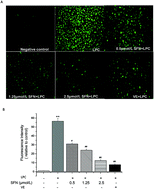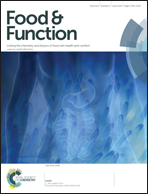Sulforaphane protected the injury of human vascular endothelial cell induced by LPC through up-regulating endogenous antioxidants and phase II enzymes
Abstract
Sulforaphane (SFN), which is an isothiocyanate (ITC) that is found in cruciferous vegetables, has received considerable attention because of its beneficial effects. In this study, the protection by SFN in the lysophosphatidylcholine (LPC)-induced injury of human vascular endothelial EA.hy.926 cells was investigated. ROS intensity was obtained by fluorescence microscopic imaging. Levels of MDA, GSH and the activity of SOD were determined spectrophotometrically. Expressions of GST, GSH-Px, TrxR and Nrf-2 proteins were measured by western blotting analysis. SFN largely decreased ROS production, similar to vitamin E. The MDA level was decreased by SFN to a level that was comparable to the negative group. Incubation with 0.5, 1.25, 2.5 μmol L−1 SFN for 24 h restored the activity of SOD by 58%, 64%, and 123%, respectively. SOD activities were individually increased by 53%, 97%, 103% after treatment with 2.5 μmol L−1 SFN for 12 h, 24 h, and 48 h, respectively. SFN restored and up-regulated the expressions of GST, GSH-Px and TrxR both in dose- and time-dependent ways. Although VE presents comparable induction of phase 2 enzymes as 1.25 μmol L−1 SFN, it cannot induce the translocation of Nrf-2 to the nucleus. SFN protected the injury of vascular endothelial cell by LPC by enhancing anti-oxidative capabilities mediated by Nrf-2 translocation.


 Please wait while we load your content...
Please wait while we load your content...